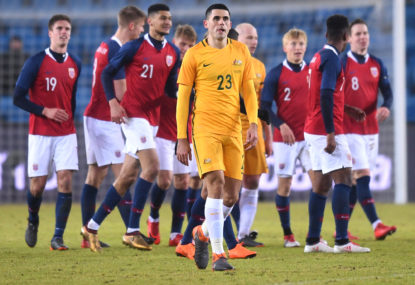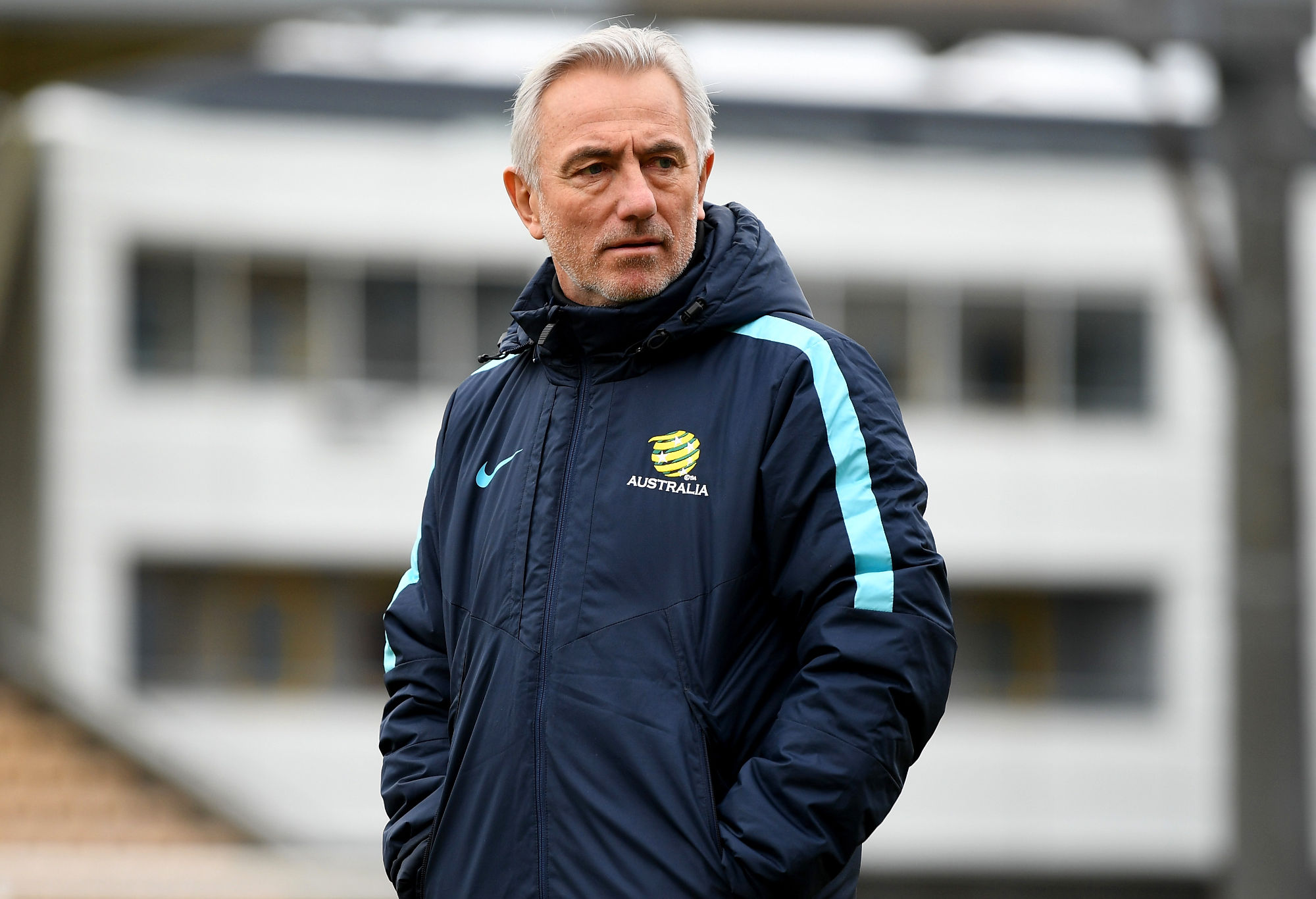Young excellence, promotion battles, and a happy farewell: The Australian team of the week from players around the globe
Even though St.Pauli ultimately lost a high-scoring affair, Jackson Irvine was a standout, as well as scoring a late goal.

The first match under the brief Bert van Marwijk era is out of the way. Here are some talking points of interest to come out of the game.
Something old, something new
Mat Ryan in goal. Aaron Mooy and Mile Jedinak in the middle. Andrew Nabbout up front?
The starting line-up provided the comfort and security of a team that had successfully navigated a tricky world cup qualifying route, but also with debut caps handed to players who are in red-hot form in the A-League.
Mat Ryan remains the best keeper Australia has to offer (notwithstanding his howler to gift Norway their third), Mile Jedinak in our last match was the midfielder and captain for Australia that got us to Russia, however up front, the more familiar faces of Tomi Juric and Tim Cahill made way for Andrew Nabbout, whose form domestically has seen him move abroad.
Dimitri Petratos was out on the left to really shake things up.
Shout out also to Mathew Leckie, who had a 50th cap that he won’t exactly be racing to recall, but in doing so became only the 33rd Australian to represent the national team 50 times or more.
The team was a combination of pragmatism with a dash of adventure that highlighted Bert van Marwijk’s first national line up, and given that on the whole it was a team picked on form, there could be few criticisms of his selections.
Neither Nabbout or Petratos looked out of place, and justified their selections with good movement on the park. Nabbout had limited chances up front, while Petratos held his own on the left, and bother were managing to link up nicely with their new national teammates. Petratos did his World Cup selection no harm.
Aleksandar Susnjar, a young man only recently making his career in Czech football with club Mlada Boleslav, also came on for his debut in the second half, and did not look out of place at left back.
Van Marwijk’s first match needed to be a balance of learning his team, knowing his options, sticking with what worked, but also trying something new on top of it.
All round, he seemed to get that balance about right.

(Photo by Michael Regan/Getty Images)
Irvine continues to deliver
Jackson Irvine, selected in a midfield role, justified his position in the starting lineup with a bullet header from a corner in the 20th minute, to be the first goalscorer for Australia under the van Marwijk reign.
It’s fair to say that Norway had the better of the opening quarter of the match, and had their striker shot more truly, they could have had an early lead.
However, van Marwijk would have been happy with the response from Australia, as they held firm and pressed in attack to earn a corner.
The delivery from Mooy was bang on, the defending from Norway was appalling, but the header and finish from Irvine delivered a finish that some top strikers in the world would be paid a pretty penny for.
The Australian team, they are hard workers, they are a tough unit, and they have been known for the rough stuff, but that clinical ability from the set-piece is usually something being finished off by Cahill.
It satisfying to see Australia not just take the lead, but do so from a nicely taken corner, with a fine finish from the young Australian, Irvine.
It was also an otherwise bright start for Australia, and it’s a shame that they weren’t able to build from that early goal.
Bailey Wright wrong right back
Bailey Wright was isolated a fair bit out on the right in defence, and ultimately led to us conceding in the first half.
It was a curious selection from van Marwijk, and it was probably the one thing he got wrong in the first half.
However, conceding four goals, the Australian defence was poor all-round.
Milos Degenek was selected in the heart of defence, with Mark Milligan, but you could not help but think that having Wright in the middle, certainly not out on the flank, would have given a sturdier resolve to the Australian defensive line.
Coming into the World Cup, Australia will want to figure out how to tighten up a leaky defence that has an innate ability to concede goals.
It was poor defending early in the second half, from the simply ill-disciplined defence of those deadly set pieces, to even conceding the free kick itself, that summed up the disappointment that is too often associated with Australian defending in football matches.
Wright was swiftly taken from the field shortly after we conceded that second goal. However, by that stage, the damage was done, and later mishaps in defence would once again see us concede a particularly soft goal to Ola Kamara.
The lengthy qualification route showed that clean sheets come at a premium for Australia, and top of van Marwijk’s to-do list must be finding a strong and workable combination of at least four men at the back that are strong, pacey, and football-smart enough to read what attackers are doing, and then make the necessary decisions about how to react.
Sure, that’s more easily said than done, but ultimately, that’s what van Marwijk is being paid a considerable amount of money to do.
Australia still cannot score goals
We scored the one goal, and that was by the Number 10.
Nabbout had very limited opportunities, and for the time he was on the park, he got very little by way of quality ball.
Tom Juric hardly fared better when he came on.
Scoring is really not something that van Marwijk can teach any of our players in national camps.
We either have goalscorers, or we don’t – it’s as simple as that.
While the likes of Argentina can consider leaving two world-class strikers out of their squad in Paolo Dybala and Mauro Icardi, to date Australia’s best goal-scoring option is 38 years old and playing occasional minutes in the English Championship – that’s a question of Australian player development, not whether van Marwijk can coach.
It might also be a question about our midfield. Australia looked largely disjointed in that first half, and were nigh on unwatchable for the open minutes of the second.
The introduction of Tom Rogic and Massimo Luongo certainly made Australia look a bit livelier, but by then Norway had scored 3 and the damage was done, so what did the substitutes have to lose?
Perhaps the issue is midfield creativity. If van Marwijk can get that midfield combination right, and all players right now are on notice, better delivery up front should then result in more goals.
So the question remains: where will Australia get goals from against France, Denmark and Peru?

(AAP Image/Dean Lewins)
Should we be concerned about that first match against France?
Hopefully not, but let’s be honest, a 4-1 loss is no pretty reading.
Truth be told, it could have been worse, but that first up performance simply was not good enough, on any level.
That was the national coach’s first match, and while it is doubtful he would have been doing somersaults over the performance, he still has a few more games, and some time, to get things the way he wants them when the World Cup starts in Russia.
Bear in mind, one of Norway’s goals was from a Mat Ryan mistake of such uncharacteristic calamity, I would wager that you will never see that happen again.
So now is not the time for Australia to be concerned about that first match against former world champion France.
If this was our final warm-up match before the tournament, I would probably be worried, but let’s see what van Marwijk can do in the next few days.
But to deliver that type of performance against a team that is outside the current top-50? Let’s hope for a more disciplined performance against Colombia, who are a top-20 ranked nation.
If we deliver this up against them again on Wednesday morning, then perhaps an alarm bell or two might be worth ringing.
How have Norway failed to qualify in 9 international tournaments in a row?
Norway was once the second-ranked international team in the world.
That surprised me during commentary when I heard that, but you think back, they once had an amazing crop of players: Solskjaer, Flo, Riise, Carew, Berg, Iverson, a generation ago, Norway had an amazing line-up of footballers.
However, when those players retired, Norway’s quality dropped off and they stopped qualifying for major international tournaments.
Australia can take a cautionary tale from that.
As a nation, who has qualified for, or at least played in, seven international tournaments in a row now (4 World Cups, 3 Asian Cups, albeit one Asian Cup hosted), Australia should never take for granted playing in these types of tournaments.
Since our supposed golden generation retired, the final lingering remnant of which is Cahill, Australia has never dealt with the issue of ensuring that we have in place structures to develop the talent to take up the mantle and take Australia to the next level of not just qualifying for the World Cup, but winning one.
Yes, we won the Asian Cup, but on home soil, you would hope that we would at least have made that final. No, it is abroad and in a World Cup that we as a country put ourselves truly on show.
When a strong footballing nation such as Norway has now failed to make Euros and World Cups, having once been the second best nation doing the rounds, Australia should be mindful to not take its place on the world stage for granted.
We need to continue the development of youth and players into international, world-class standard players, and with the FFA in its current form struggling just to organise a feasible domestic game, it’s questionable where the next generation of world-class players is coming from.
For Norway, who would never take World Cup and Euros qualification for granted given how hard it is to navigate European qualifiers, whether it is simply a weight of population numbers, or a matter of economics, perhaps they can look to a brighter future.
Ola Kamara scored a well-earned hat-trick, and Mohammed Elyounoussi delivered some quality moments for the home side. Meanwhile, Martin Odegaard has a real ray of hope about him as he makes his way with Real Madrid.
Here’s hoping that the current crop of players can return a great footballing nation back to the halcyon days of international tournaments.